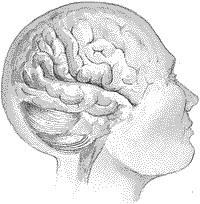Alters are the basis of multiple personality disorder and dissociative identity disorder.They emerge from the core personality, or the original identity, that is born within the body and brain. When the patient experiences more trauma than s/he can withstand but there is no chance of physical escape, the patient develops an alter ego, or an alter personality state. This personality is constructed to accept and deal with the trauma as it happens. The patient then retreats somewhere inside her or his head and doesn’t emerge until the crisis is over. In one rare case of MPD, the initial trauma was so extreme that the original patient regressed into an infantile state and never re-emerged for the rest of her life.
DID is rare or it isn’t rare depending upon who you ask. The circumstances that generally accompany this disorder are so extreme and repetitive as to be very unlikely. Dr. Richard Baer, the psychiatrist who treated Karen Overhill, stated, you have to be very, very careful about suggesting things to a patient. I think these [multiple personality] patients are very, very rare because of the circumstances required to create them. It takes a significant amount of trauma to cause a person to start to disassociate from it and that trauma has to take place over a sustained period of time, bringing with it multiple disassociations that become established as “alters.”
Types of Trauma Trauma doesn’t only refer to abuse. There are many types of trauma that a person can suffer and many reactions can result from any of them. Dissociation is one of many psychological defenses that protect people from harm although it doesn’t happen to everyone who experiences great trauma.
 Ritual Child Abuse Extreme sexual, emotional and physical ritual abuse in childhood is a common trait among people with MPD or DID. It is believed that this is a cause of MPD but there is a problem with this theory. Not everyone who has MPD has been sexually, emotionally or physically abused. To be sure, repetitive, extreme abuse has to have a long-term effect on the patient. Developing multiple egos to distance oneself from pain and fear is a highly successful reaction to this type of abuse. The original personality leaves the situation and another emerges to tolerate the abuse, leaving the original, the “owner” of the body, unaware that abuse exists.
Ritual Child Abuse Extreme sexual, emotional and physical ritual abuse in childhood is a common trait among people with MPD or DID. It is believed that this is a cause of MPD but there is a problem with this theory. Not everyone who has MPD has been sexually, emotionally or physically abused. To be sure, repetitive, extreme abuse has to have a long-term effect on the patient. Developing multiple egos to distance oneself from pain and fear is a highly successful reaction to this type of abuse. The original personality leaves the situation and another emerges to tolerate the abuse, leaving the original, the “owner” of the body, unaware that abuse exists.
Extreme Duress
In the biography The Three Faces of Eve and later in her own autobiography I Am Eve, Christine Sizemore discussed how she began her experience as a multiple. At the age of two Sizemore witnessed a terrible accident at a sawmill where her father worked; a man was severed in half. As Sizemore’s mother held her and ran toward the accident, she mumbled to herself that the men were “careless” and she worried aloud whether it was Sizemore’s father who had died. Sizemore remembered being at the side of the pit where the worker’s body lay and, becoming overwhelmed with fear, she looked across the pit to see another little red-haired girl who looked calmly down into the pit. Of course, the little girl wasn’t real. This was Sizemore’s first “split”, as it is often called.
 Extreme duress could also include the experience of war veterans, children suffering from long-term disease or illness, chaotic households, and many other situations, although these are not known to elicit MPD. Why it is that one type of stressor and not another results in a dissociation of the mind hasn’t been fully explored. There is the suggestion that some people are more “resilient” and do not need to retreat somewhere else into the mind.
Extreme duress could also include the experience of war veterans, children suffering from long-term disease or illness, chaotic households, and many other situations, although these are not known to elicit MPD. Why it is that one type of stressor and not another results in a dissociation of the mind hasn’t been fully explored. There is the suggestion that some people are more “resilient” and do not need to retreat somewhere else into the mind.
What Alters Do An alter steps forward to take the place of a person who is overwhelmed during a severe traumatic episode and maintains control over the body until the trauma has passed. This alter experiences the trauma but the original person doesn’t. There may be several alters who fulfill this function. Some may develop at the same time during an extremely stressful incident. Others may develop later in life. Although it was once thought that alters only developed in childhood up to the age of 10, it is now believed that alters can begin in adulthood.
Types of Alters Alters are as unique as the individuals who possess them. No two people have the exact same alter, anymore than a person without MPD is exactly the same as another person. There are similarities however and most multiples possess a general form of personality states who fulfill specific functions. These include:
Pain There is usually an alter has no “choice” in experiencing physical abuse and is made from sheer  desperation by the original person. This alter emerges when danger is nearby. The original person disappears into the mind and the new alter suffers the abuse or trauma.There may be more than one alter who suffers physical abuse.
desperation by the original person. This alter emerges when danger is nearby. The original person disappears into the mind and the new alter suffers the abuse or trauma.There may be more than one alter who suffers physical abuse.
Information There is almost always one alter who possesses significant information that is relayed to the therapist This alter generally knows how many alters the patient possesses, who they are, their names, and their functions. If anyone was considered an eavesdropper, this alter would be it. The alter never suffers abuse and has no memory of it.
Child There is usually a regressed alter who hasn’t had the chance to mature into adulthood due to the repression of the childhood environment. The child alter stays carefully hidden during the patient’s youth and tends to emerge under safe circumstances, usually when the patient is older and typically is in therapy,
Sexual Alter This alter emerges when the patient engages in sexual activity of any sort. This alter is the one who suffers sexual abuse, and particularly pleasure that has been taught during abuse. In that way, the guilt and shame of sexuality is visited upon the sexual alter and not the patient.
Suicidal Alter Often there is a suicidal alter who simply cannot recover from the childhood and possibly teenage  trauma. This personality state cannot cope and wishes to die however this alter has no concept of “killing” the others. S/he doesn’t understand that if s/he successfully commits suicide, all alters and the patient will die. Other alters rally around the suicidal alter when s/he/it emerges to prevent the suicide.
trauma. This personality state cannot cope and wishes to die however this alter has no concept of “killing” the others. S/he doesn’t understand that if s/he successfully commits suicide, all alters and the patient will die. Other alters rally around the suicidal alter when s/he/it emerges to prevent the suicide.
Opposite Gender Alter Sometimes multiples have both men and women (or boys and girls) living within their minds. Sometimes these alters develop due to the admiration of a person of the opposite sex, or the erroneous belief that had s/he been born the opposite sex, the abuse would never have happened. Truddi Chase who wrote “When Rabbit Howls“, an autobiography of her life as a multiple, possessed a strong, black, male alter named Mean Joe Green. Green was a famous, professional football player when Chase was in her youth. She also saw him as a kind man. She personified him as an alter by his nickname and he functioned as a “protector” for the children.
Protector This alter is always hovering in the wings in case danger emerges. This alter usually prevents danger by physically removing the patient from a situation before harm can happen. The protector may well be responsible for occasional fugue states when the patient travels a considerable distance under duress but has no idea how s/he arrived at the end destination. Strangely, the protector can function in a dual role and also commit self-harm against the patient.
 Self-Abuse This alter continues the punishment and hatred of the patient’s childhood abuser. The concept has been placed firmly in the patient’s mind that s/he was very “bad” as a child and deserved the abuse. Ergo, throughout adulthood the patient holds this same false belief and punishes him/herself by committing abusive acts against the body such as cutting and slashing with a razor, burning, attempting to “murder” the body. The self-abusing alter perpetuates the abuse cycle. The self-abuse alter often states that s/he hates the patient,
Self-Abuse This alter continues the punishment and hatred of the patient’s childhood abuser. The concept has been placed firmly in the patient’s mind that s/he was very “bad” as a child and deserved the abuse. Ergo, throughout adulthood the patient holds this same false belief and punishes him/herself by committing abusive acts against the body such as cutting and slashing with a razor, burning, attempting to “murder” the body. The self-abusing alter perpetuates the abuse cycle. The self-abuse alter often states that s/he hates the patient,
Mother The patient mothers her own child but she may not be present during the birth due to the extreme pain of labour. The patient may regress inward and the alter who experiences pain births the infant. Ergo the patient has no memory of the birth or even parts of the pregnancy but is prepared to mother the child.Other alters emerge during child-rearing but usually they claim no “ownership” of the child, including the alter that has birthed it. There is usually a strong bond between the patient and child. Seldom does the patient abuse her own child.
The Abuser This alter replaces the actual abuser, whether s/he is a parent, guardian, or another individual. The patient develops this alter as a sign of self-hatred. The abuser taunts and torments the alter. The cyclical abuse continues.
Pairs Sometimes two alters emerge as one. They fulfill the same purpose and even have separate names. They may not be the same race or gender. For whatever reason, these alters feel the need for their own alter in order to function.
Animal It has been reported that some patients have an animal alter but I have never encountered such a case in my research and readings. Supposedly this alter replaces a childhood pet that was either abused to death by the abuser or ran away, or died of old age.
Relative Patients have alters who are representative of a relative in their family who has been kind to them, and has not been a threat. This alter tends to develop due to the death of this person. The death is too distressing for the patient and an alter develops who replaces the deceased loved one.
Employee – Someone has to work in order to earn a living. Sometimes an alter who can work with colleagues and if necessary the public fills this role. Sometimes it is the original personality. Sometimes there is a switching between the two or other alters may also materialize to maintain order and minimize stress during the course of the day.
Alters aren’t sketched in stone. Sometimes their functions may overlap. In one day, several alters may control the body, depending on the functions that are required. During this time, the patient seems to lose track of time. “Losing time” has long been thought to be a major characteristic of people with MPD or DID although this may not be true for everyone. MPD and DID have many different symptoms and not all of them can be listed in one blog, since many symptoms may not be public knowledge, or have even been discovered.
Characteristics of Alters Sometimes alters are unaware of each other. Sometimes some alters are aware of some alters but not others. These states are called amnesia, and there are different types.
Amnesia Barrier Most patients claim they have no knowledge of their alters. Sometimes alters claim not to know about each other. This concept is being challenged in the psychiatric community. Lab experiments fail to locate an amnesia barrier. The film The Three Faces of Eve demonstrated an alter named Eve Black who claimed “I know everything about her [the patient]”, but the knowledge wasn’t mutual.
Repression Rather than amnesia, it is possible that patients experience repression of their alternate selves. There may be no “amnesia barrier”, but rather alters are repressed when the patient feels threatened. The implication is that the patient is aware of interactions with other people but s/he chooses to allow alters to take control over the body during the situation.
 Milligan’s alters had distinctly different personalities and existed to serve different purposes. One alter named April, sought to kill Milligan’s stepfather. Another, a lesbian named Bad Lana, was responsible for the rapes that led to his arrest. Kevin dealt drugs and planned a robbery. Dana was the 8-year-old Keeper of Pain. Ragan was a thief. Christopher, a happy, earnest 13-year-old with a British accent liked to play the harmonica. Tommy was a hostile 16-year-old teenager. Christine, who loved candy, learned to answer to the name Billy. Cathy, a toddler, was still learning how to walk. There were boys named Shawn, Philip, Jimbo and Arthur. There were Undesirables, whom Arthur, who was supposed to be a protector, “sent away” when they were “no longer functional.” The Teacher was the sole personality who “was able to put them all together.”
Milligan’s alters had distinctly different personalities and existed to serve different purposes. One alter named April, sought to kill Milligan’s stepfather. Another, a lesbian named Bad Lana, was responsible for the rapes that led to his arrest. Kevin dealt drugs and planned a robbery. Dana was the 8-year-old Keeper of Pain. Ragan was a thief. Christopher, a happy, earnest 13-year-old with a British accent liked to play the harmonica. Tommy was a hostile 16-year-old teenager. Christine, who loved candy, learned to answer to the name Billy. Cathy, a toddler, was still learning how to walk. There were boys named Shawn, Philip, Jimbo and Arthur. There were Undesirables, whom Arthur, who was supposed to be a protector, “sent away” when they were “no longer functional.” The Teacher was the sole personality who “was able to put them all together.” Roth thanked Billy for bringing her an apple, which confused him since he had no recollection of the incident. Arthur awoke in his place to find himself wearing two different coloured socks. Billy awoke and was startled to discover he had written a math test.
Roth thanked Billy for bringing her an apple, which confused him since he had no recollection of the incident. Arthur awoke in his place to find himself wearing two different coloured socks. Billy awoke and was startled to discover he had written a math test. Milligan drew and painted a number of work, including a beautifully depicted landscape. Milligan also painted seven of his alters, including a woman and a little girl. He named them Allen, Tommy, Arthur, Adalana, Christene, Ragen, and Kevin.
Milligan drew and painted a number of work, including a beautifully depicted landscape. Milligan also painted seven of his alters, including a woman and a little girl. He named them Allen, Tommy, Arthur, Adalana, Christene, Ragen, and Kevin. 











 Rabbit Howls”
Rabbit Howls” 




















